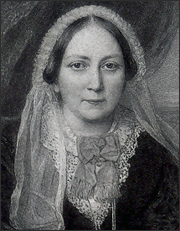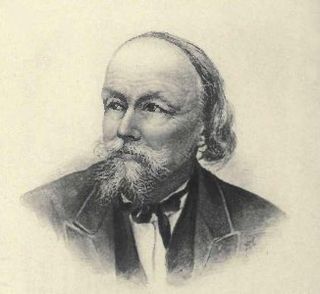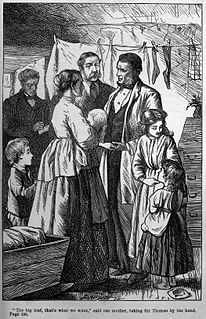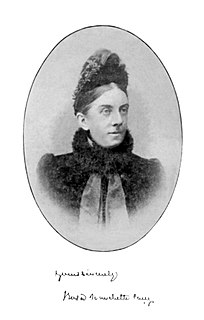Related Research Articles

Mary Elizabeth Braddon was an English popular novelist of the Victorian era. She is best known for her 1862 sensation novel Lady Audley's Secret, which has also been dramatised and filmed several times.
Events from the year 1868 in literature .

Tom Hood was an English humorist and playwright, and son of the poet and author Thomas Hood. A prolific author, in 1865 he was appointed editor of the magazine Fun. He founded Tom Hood's Comic Annual in 1867.

Bayard Taylor was an American poet, literary critic, translator, travel author, and diplomat. As a poet, he was very popular, with a crowd of more than 4,000 attending a poetry reading once, which was a record that stood for 85 years. His travelogues were popular in both the United States and Great Britain. He served in diplomatic posts in Russia and Prussia.

Edmund Hodgson Yates was a British journalist, novelist and dramatist.

William Hepworth Dixon was an English historian and traveller from Manchester. He was active in organizing London's Great Exhibition of 1851.
James Hannay FRSE, was a Scottish novelist, journalist and diplomat.

Ellen Price was an English novelist better known as Mrs. Henry Wood. She is best remembered for her 1861 novel East Lynne. Many of her books sold well internationally and were widely read in the United States. In her time, she surpassed Charles Dickens in fame in Australia.

John Habberton was an American author and journalist.

Benjamin Leopold Farjeon was an English novelist, playwright, printer and journalist. As an author, he was known for his huge output.

Charlotte Riddell, known also as Mrs J. H. Riddell, was a popular and influential Irish-born writer in the Victorian period. She was the author of 56 books, novels and short stories, and also became part-owner and editor of St. James's Magazine, a prominent London literary journal in the 1860s.

William Tinsley was a British publisher. The son of a gamekeeper, he had little formal education; but together with his brother Edward (1835–1865) he founded the firm of Tinsley Brothers, which published many of the leading novelists of the time.
Annie Hall Cudlip, writing as Mrs. Pender Cudlip) was an English novelist and writer. She edited Ours: A Holiday Quarterly and contributed regularly to All the Year Round, Frank Leslie's Popular Monthly, and other magazines in Britain and the United States between 1876 and 1884. Married to a theologian, Rev. Pender Hodge Cudlip, she was among the most prolific writers of romantic fiction: well over 100 novels and short stories between 1862 and the early 20th century. The best known include Theo Leigh (1865), A Passion in Tatters (1872), He Cometh Not, She Said (1873) and Allerton Towers (1882).

Ralph the Heir is a novel by Anthony Trollope, originally published in 1871. Although Trollope described it as "one of the worst novels I have written", it was well received by contemporary critics. More recently, readers have found it noteworthy for its account of a corrupt Parliamentary election, an account based closely on Trollope's own experience as a candidate.
Emma Jane Guyton or Worboise was an English novelist, biographer and editor. Her more than 50 novels feature strong Christian values and were popular in their time.

Rosa Nouchette Carey was an English children's writer and popular novelist, whose works reflected the values of her time and were thought of as wholesome for girls. However, they are "not entirely bereft of grit and realism."
Charles Maurice Davies (1828–1910) was an Anglican clergyman, writer and spiritualist.
James Edward Davis was called to the bar at the Middle Temple in 1842, was stipendiary magistrate at Stoke upon Trent from 1864 to 1870, was police magistrate at Sheffield from 1870 to 1874, and was a friend of Leigh Hunt.
This is a list of the works of Henry James, an American writer who spent the bulk of his career in Britain.

Matilda Charlotte Houstoun was a British travel writer, novelist, biographer, and women's right activist. She is best known for her series of travel writings, particularly Texas and the Gulf of Mexico (1844) and Hesperos, and their observations about African-American life during the times of the Confederate Deep South. Later on, she turned her pen from novels to social reform, particularly on the rights of working class women and single mothers. During her lifetime, her best known work was Recommended to Mercy, a female-driven "yellow-back" novel published in 1862.
References
- 1 2 3 "At the Circulating Library Author Information: Mrs. Pemberton". 4 August 2019. Archived from the original on 4 August 2019. Retrieved 4 August 2019.
- ↑ "The History of Monaco, Past and Present. By H. Pemberton. » 22 Feb 18…". 19 December 2018. Archived from the original on 19 December 2018. Retrieved 15 March 2019.
- ↑ "Contemporary Literature". The London Chronicle. I. 4 January 1868. Retrieved 15 March 2019.
- ↑ "Pemberton's History of Monaco". The Saturday Review of Politics, Literature, Science, Art, and Finance. 25. 13 June 1868. Retrieved 15 March 2019.
- 1 2 Pemberton, H. (19 September 1868). "A winter tour in Spain". London : Tinsley Brothers. Retrieved 19 September 2019– via Internet Archive.
- ↑ "Tinsleys' Magazine". XV. July–December 1874. Retrieved 14 March 2019.
{{cite journal}}: Cite journal requires|journal=(help) - ↑ "Tinsley Brothers' New Novels". The Spectator. 47. 14 March 1874. Retrieved 15 March 2019.
- ↑ "Dacia Singleton". London : Tinsley Brothers. 19 September 1867. Retrieved 19 September 2019– via Internet Archive.
- ↑ "Not in Sadleir; Wolff 5516, citing several letters between himself and a librarian, in which the identity of 'Mrs Pemberton' is discussed. Copac lists four copies, two of which (Cambridge & NLS) are attributed to Mrs Pemberton; the BL and Oxford do not give an author. Victorianresearch.org identifies the author as Helen Etough Gipps, née Crookshank, 1830-1877, author of seven three-decker novels. She was embroiled in a divorce scandal in the 1860s and, perhaps wishing to avoid the negative publicity, published her society novels pseudonymously. Will is the Cause of Woe was her last novel, published posthumously." Source: https://www.jarndyce.co.uk/stock_detail.php?stockid=83814
- ↑ "Will is the Cause of Woe". www.jarndyce.co.uk. Retrieved 19 September 2019.
- 1 2 "Gipps v Gipps". Journal of the House of Lords. 96. 1864. Retrieved 4 August 2019.